Background
Ingrid D. Rowland was born on August 19, 1953, in Princeton, New Jersey, United States. She is a daughter of Frank Sherwood and Joan Evelyn Rowland.

Pomona College, Claremont, California, United States
In 1974 Ingrid D. Rowland received her Bachelor of Arts degree from Pomona College.
Bryn Mawr College, Bryn Mawr, Pennsylvania, United States
In 1976 Ingrid D. Rowland obtained a Master of Arts degree from Bryn Mawr College, and a Doctor of Philosophy degree in 1980.
Ingrid D. Rowland. Photo by Aaron Salcido.
Ingrid D. Rowland
Ingrid D. Rowland







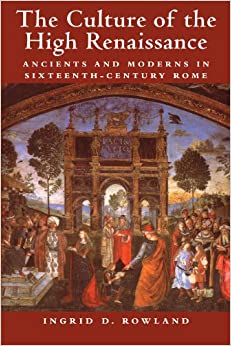
(Between 1480 and 1520, a concentration of talented artist...)
Between 1480 and 1520, a concentration of talented artists, including Melozzo da Forlì, Bramante, Pinturicchio, Raphael, and Michelangelo, arrived in Rome and produced some of the most enduring works of art ever created. This period, now called the High Renaissance, is generally considered to be one of the high points of Western civilization. How did it come about, and what were the forces that converged to spark such an explosion of creative activity? In this study, Ingrid Rowland examines the culture, society, and intellectual norms that generated the High Renaissance. This interdisciplinary 2001 study assesses the intellectual paradigm shift that occurred at the turn of the fifteenth century. It also finds and explains the connections between ideas, people, and the artworks they created by looking at economics, art, contemporary understanding of classical antiquity, and social conventions.
https://www.amazon.com/Culture-High-Renaissance-Ancients-Sixteenth-Century/dp/0521794412/ref=sr_1_1?dchild=1&keywords=The+Culture+of+High+Renaissance%3A+Ancients+and+Moderns+in+Sixteenth-Century+Rome&qid=1589370379&s=books&sr=1-1
1998
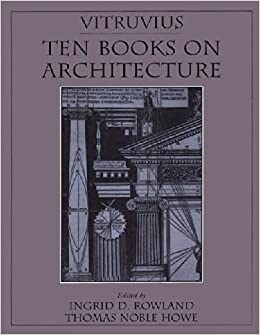
(The only full treatise on architecture and its related ar...)
The only full treatise on architecture and its related arts to survive from classical antiquity, the De Architectura libri decem (Ten Books on Architecture) is the single most important work of architectural history in the Western world, having shaped humanist architecture and the image of the architect from the Renaissance to the present. This new, critical edition of Vitruvius' Ten Books of Architecture is the first to be published for an English-language audience in more than half a century. Expressing the range of Vitruvius' style, the translation, along with the critical commentary and illustrations, aims to shape a new image of the Vitruvius who emerges as an inventive and creative thinker, rather than the normative summarizer, as he was characterized in the Middle Ages and Renaissance.
https://www.amazon.com/Vitruvius-Ten-Books-Architecture-ebook/dp/B00IE6MQ3Q/ref=sr_1_5?dchild=1&keywords=Vitruvius%3A+Ten+Books+of+Architecture&qid=1589370694&s=books&sr=1-5
1999
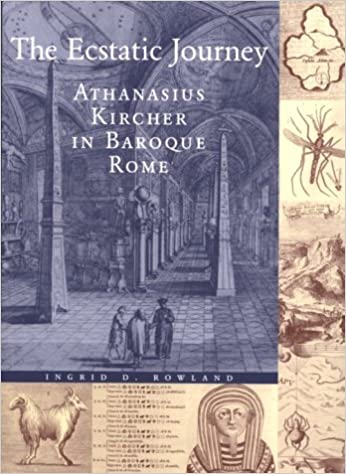
(The Ecstatic Journey: Athanasius Kircher in Baroque Rome ...)
The Ecstatic Journey: Athanasius Kircher in Baroque Rome surveys the scientific, religious, and political culture of seventeenth-century Rome through the works of Athanasius Kircher (1602-1680), a German Jesuit at the Roman College. Published in conjunction with an exhibition held in the Department of Special Collections at the University of Chicago's Regenstein Library, this illustrated catalog includes an essay by Ingrid D. Rowland and descriptions of over 100 works. The introduction by F. Sherwood Rowland, 1995 Nobel laureate in Chemistry, offers an appreciation of Kircher and observations on the idea of scientific progress.
https://www.amazon.com/Ecstatic-Journey-Athanasius-Kircher-Baroque/dp/094305625X/ref=sr_1_1?dchild=1&keywords=The+Ecstatic+Journey%3A+Athanasius+Kircher+in+Baroque+Rome&qid=1589371008&s=books&sr=1-1
2000
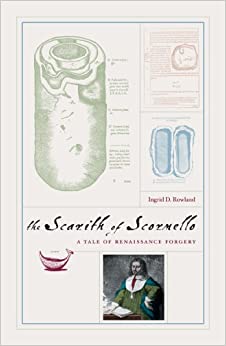
(Bored teenager Curzio Inghirami staged perhaps the most o...)
Bored teenager Curzio Inghirami staged perhaps the most outlandish prank of the seventeenth century when he hatched a wild scheme that preyed on the Italian fixation with ancestry by forging an array of ancient Latin and Etruscan documents. Stashing the counterfeit treasure in scarith (capsules made of hair and mud) near Scornello, Curzio reeled in seventeenth-century Tuscans who were eager to establish proof of their heritage and history. However, despite their excitement, none of these proud Italians could actually read the ancient Etruscan language, and they simply perpetuated the hoax. Written with humor and energy by Renaissance expert Ingrid Rowland, The Scarith of Scornello traces the career of this young scam artist whose "findings" reached the Vatican shortly after Galileo was condemned by the Inquisition, inspiring participants on both sides of the affair to clash again - this time over Etruscan history. In her investigation of this seventeenth-century caper, Rowland captivates readers with her obvious delight in Curzio's far-reaching prank.
https://www.amazon.com/Scarith-Scornello-Tale-Renaissance-Forgery/dp/0226730379/ref=sr_1_fkmr0_1?dchild=1&keywords=The+Scarith+of+Scornello%3A+a+Tale+of+Renaissance+Forger&qid=1589371491&s=books&sr=1-1-fkmr0
2004
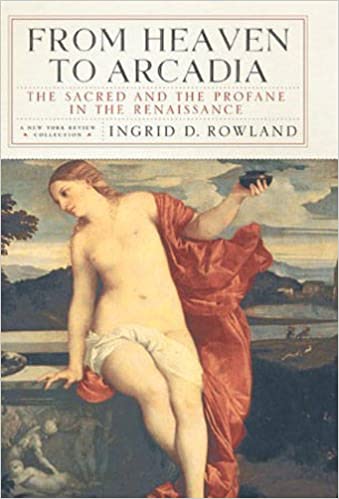
(From the revelations of classical statuary pulled from th...)
From the revelations of classical statuary pulled from the Roman soil as the popes began rebuilding the city in the fifteenth century, to the myth of serenity that Venice constructed to conceal its physical and political fragility, to bloody yet cultured Florence under the Medici, Ingrid D. Rowland traces the worldly, unworldly, and otherworldly strivings of artists, writers, popes, and politicians during that great “outburst of mental energy” we know as the Renaissance.
https://www.amazon.com/Heaven-Arcadia-Profane-Renaissance-Paperback/dp/1590172957/ref=sr_1_1?dchild=1&keywords=From+Heaven+to+Arcadia%3B+The+Sacred+and+the+Profane+in+the+Renaissance&qid=1589371693&s=books&sr=1-1
2005
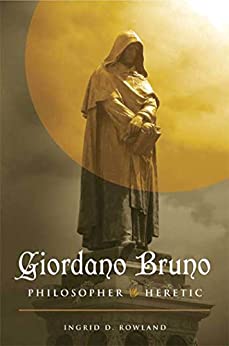
(Giordano Bruno is one of the great figures of early moder...)
Giordano Bruno is one of the great figures of early modern Europe, and one of the least understood. Ingrid D. Rowland's pathbreaking life of Bruno establishes him once and for all as a peer of Erasmus, Shakespeare, and Galileo, a thinker whose vision of the world prefigures ours. By the time Bruno was burned at the stake as a heretic in 1600 on Rome's Campo dei Fiori, he had taught in Naples, Rome, Venice, Geneva, France, England, Germany, and the "magic Prague" of Emperor Rudolph II. His powers of memory and his provocative ideas about the infinity of the universe had attracted the attention of the pope, Queen Elizabeth - and the Inquisition, which condemned him to death in Rome as part of a yearlong jubilee.
https://www.amazon.com/Giordano-Bruno-Philosopher-Ingrid-Rowland-ebook/dp/B01CXO4WNG/ref=sr_1_1?dchild=1&keywords=Giordano+Bruno%2C+Philosopher%2FHeretic&qid=1589372311&s=books&sr=1-1
2008
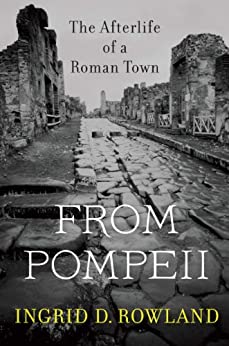
(The calamity that proved lethal for Pompeii inhabitants p...)
The calamity that proved lethal for Pompeii inhabitants preserved the city for centuries, leaving behind a snapshot of Roman daily life that has captured the imagination of generations, including Renoir, Freud, Hirohito, Mozart, Dickens, Twain, Rossellini, and Ingrid Bergman. Interwoven is the thread of Ingrid Rowland's own impressions of Pompeii.
https://www.amazon.com/Pompeii-Ingrid-D-Rowland-ebook/dp/B00JM7E03A/ref=sr_1_1?dchild=1&keywords=From+Pompeii%3A+the+Afterlife+of+a+Roman+Town&qid=1589373366&s=books&sr=1-1
2014
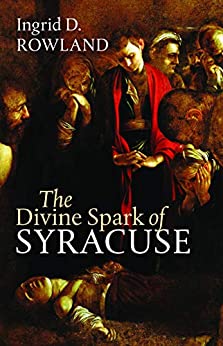
(Focusing on the figures of Plato, Archimedes, and Caravag...)
Focusing on the figures of Plato, Archimedes, and Caravaggio, The Divine Spark of Syracuse discloses the role that Syracuse, a Greek cultural outpost in Sicily, played in fueling creative energies. Among the topics this book explores are Plato and the allegory of the cave, and the divine spark mentioned in his Seventh Letter. It also considers the machines of Archimedes, including his famous screw, and the variety of siege and anti siege weapons that he developed for the defense of his hometown during the siege of Syracuse during the Second Punic War, including “the hand” (a giant claw), the “burning mirror,” and the catapult. The final chapter offers a look at the artist and roustabout Caravaggio. On the run after yet another street brawl, Caravaggio traveled to Syracuse, where he painted Burial of St. Lucy (Santa Lucia) in 1608. Typical of his late works, the painting is notable for its subdued tones and emotional and psychological delicacy. This captivating book lends clear insight into the links between the sense of place and inspiration in philosophy, mathematics, and art. Rowland is the most learned tour guide we could ask for.
https://www.amazon.com/Divine-Syracuse-Mandel-Lectures-Humanities-ebook/dp/B07PS3YK4F/ref=sr_1_1?dchild=1&keywords=The+Divine+Spark+of+Syracuse&qid=1589373866&s=books&sr=1-1
2018
Ingrid D. Rowland was born on August 19, 1953, in Princeton, New Jersey, United States. She is a daughter of Frank Sherwood and Joan Evelyn Rowland.
In 1974 Ingrid D. Rowland received her Bachelor of Arts degree from Pomona College. In 1976 she obtained a Master of Arts degree from Bryn Mawr College. In 1980 Rowland gained a Doctor of Philosophy degree from the same college.
From 1979 to 1982 Ingrid D. Rowland was a lecturer at Saint Mary's College. From 1983 to 1987 she worked as a visiting assistant professor at the University of California, Los Angeles. From 1987 to 1991 she served as an associate specialist at the University of California, Irvine School of Physical Sciences. In 1989 Rowland was an adjunct professor at the Notre Dame School of Architecture.
From 1990 to 1997 Roland was an assistant professor at the University of Chicago and an associate professor from 1997 to 2001. In 2001 she was appointed the Andrew W. Mellon Professor in the Humanities at the American Academy in Rome, serving until 2005. Since 2006 she has been a professor at the School of Architecture, University of Notre Dame and at the University of Notre Dame since 2016.
A frequent contributor to the New York Review of Books, she is the author of The Culture of the High Renaissance: Ancients and Moderns in Sixteenth-Century Rome (1998), The Scarith of Scornello: A Tale of Renaissance Forgery (2004), From Heaven to Arcadia (2005), Giordano Bruno, Philosopher/Heretic (2008), From Pompeii: The Afterlife of a Roman Town (2013), Villa Taverna (2014), and The Collector of Lives: Giorgio Vasari and the Invention of Art (2017) co-written with Noah Charney.
(The only full treatise on architecture and its related ar...)
1999(From the revelations of classical statuary pulled from th...)
2005(The calamity that proved lethal for Pompeii inhabitants p...)
2014(Bored teenager Curzio Inghirami staged perhaps the most o...)
2004(The Ecstatic Journey: Athanasius Kircher in Baroque Rome ...)
2000(Between 1480 and 1520, a concentration of talented artist...)
1998(Focusing on the figures of Plato, Archimedes, and Caravag...)
2018(Giordano Bruno is one of the great figures of early moder...)
2008Ingrid D. Rowland counts Harry Carroll as a major influence. In the interview on the question "Is there a teacher or professor who really influenced you?", she answered: "Harry Carroll at Pomona College. He was my advisor, and there were several of us at Pomona who took so many classes from him. He was in the Classics Department, and so he’d teach art history, history, what archaeology there was, and then he also taught Greek and Latin. So he did everything. And he was this little tiny Irish guy from Akron, Ohio. Totally eccentric, but it was only really after he had died that we realized how refined he was, just an incredibly refined intellect."
Ingrid D. Rowland is a member of the American Academy of Arts and Sciences and a corresponding member of the Accademia dei Sepolti of Volterra and the Accademia degli Intronati of Siena.
